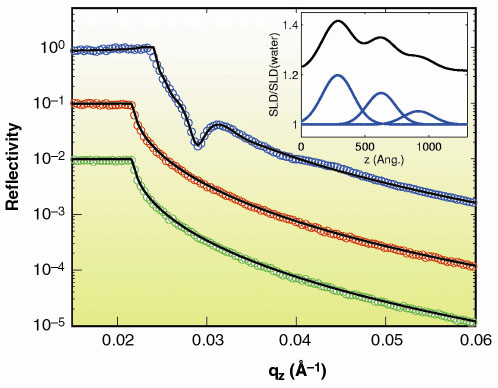- Home
- Users & Science
- Scientific Documentation
- ESRF Highlights
- ESRF Highlights 2001
- Soft Condensed Matter
- Layering of Spherical Particles at the Air/Water Interface
Layering of Spherical Particles at the Air/Water Interface
The liquid/vapour interface is well known in everyday life. Less well known is that interesting ordering phenomena can occur in the vicinity of such an interface. These phenomena appear as a consequence of the abrupt truncation of the media by the interface. We have investigated a suspension of colloidal silica particles in water. SAXS (small-angle X-ray scattering) data taken at beamline ID10A on bulk samples indicate that the sample consists of randomly distributed "hard-sphere" like particles with an effective radius of R = 175 Å. The air/liquid interface of the sample was characterised by X-ray reflectivity and GISAXS (grazing incidence small angle X-ray scattering) at ID10B.
 |
Fig. 54: X-ray reflectivity profiles of the concentrated (blue) and dilute sample (red), and of the water solvent (green). The red and green curves have been offset by one and two decades, respectively. The scattering length profile of the concentrated sample is modelled by three gaussians as indicated by the inset in the figure. |
X-ray reflectivity profiles taken on a concentrated sample, a dilute sample, and on the water solvent are shown in Figure 54. The curves for the dilute sample and water are indistinguishable. They can be perfectly fitted with Fresnel reflectivity profiles (solid lines) multiplied by a Debye-Waller term to account for the "fuzziness" of the interface caused by thermally excited capillary waves. The curve for the concentrated sample shows pronounced deviations from this simple behaviour. The larger critical angle reflects the increased scattering length density (SLD) of the sample and the oscillations of the profile indicate a varying SLD along the surface normal direction (z direction). The Parratt formalism was used to model the X-ray reflectivity profile (solid line) and the corresponding SLD profile is shown in the inset of Figure 54. This result indicates a layering of particles parallel to the interface.
GISAXS was performed to probe the lateral arrangement of particles near the surface for both the dilute and the concentrated sample. The ratio of the two profiles defines a "GISAXS structure factor" for the concentrated sample. The peak position and width of the GISAXS structure factor indicates a distance D = 570 Å between particles at the surface, and a similar correlation length This shows that the lateral arrangement of particles at the surface is random, like in the bulk. The simplest possible model for the particle organisation near the surface is shown in Figure 55. With D = 570 Å and R = 175 Å, we find z0 = 277 Å (see Figure 55) which is close to the distance between the surface and the position of the first peak in the SLD profile (Figure 54, inset). Hence, in this model the particles are touching the interface with their perimeter and the oscillating SLD profile indicates the presence of particle layers that do overlap.
 |
| Fig. 55: Model for the spatial arrangement of colloidal nanoparticles near the air/water interface. |
Principal Publication and Authors
A. Madsen, O. Konovalov, A. Robert and G. Grübel, Phys. Rev. E., 64, 061406 (2001).
ESRF



